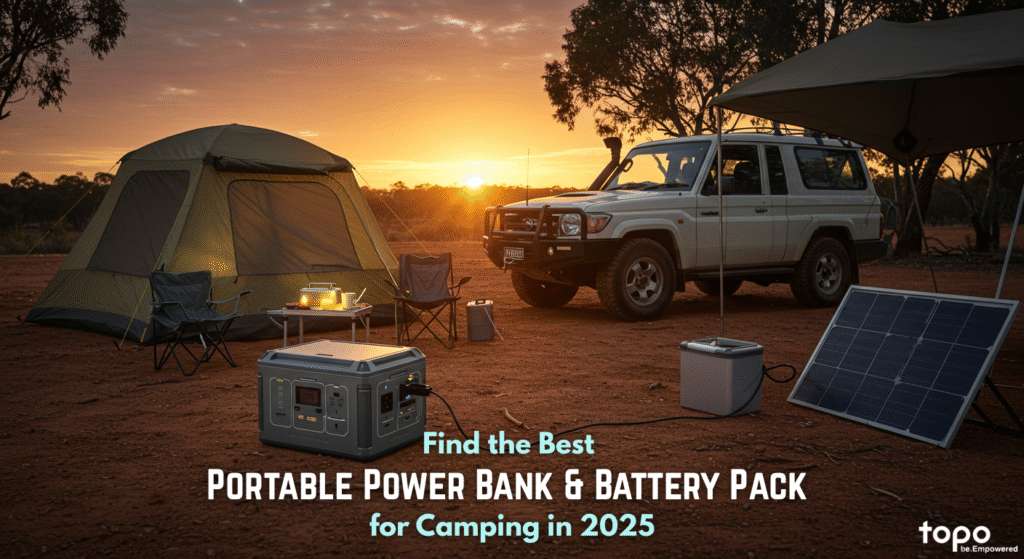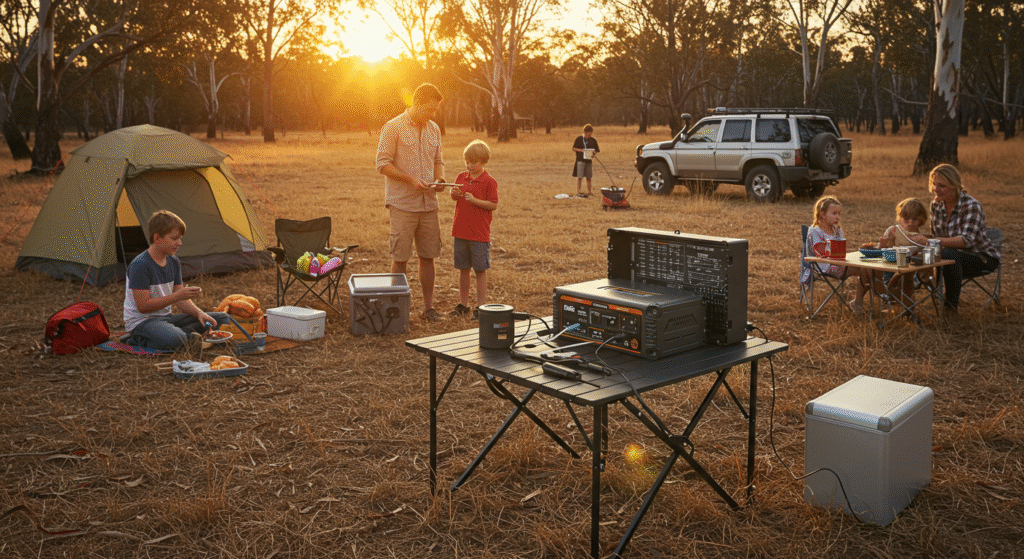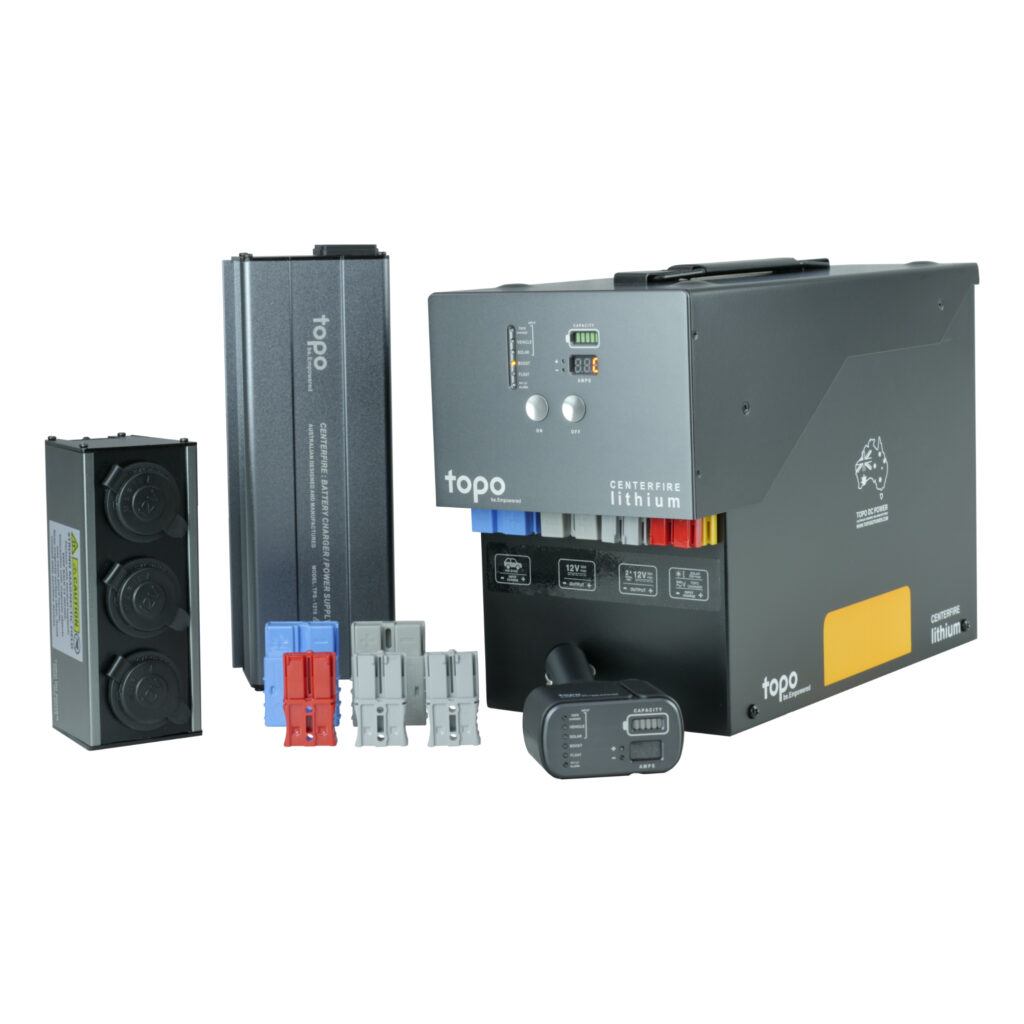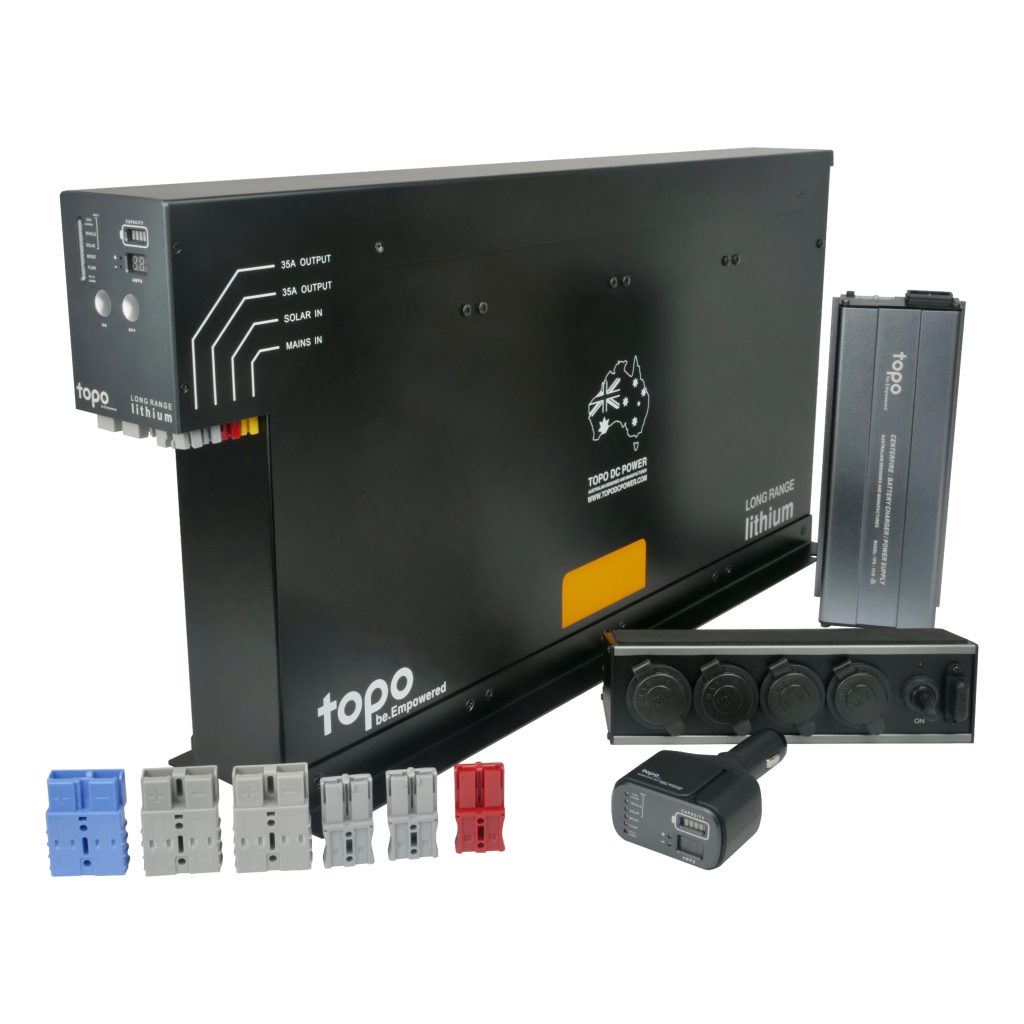
Imagine being on a remote camping trip in the Australian outback. Your GPS has run out of battery. Your lantern is dying. And the nearest power outlet is miles away. Getting caught powerless in harsh terrain is every camper’s nightmare.
That’s why having a reliable power bank or battery pack for camping is essential in 2025.
These portable power stations keep your devices charged and your campsite lit which gives you safety and peace of mind.
In this guide, we’ll explain why portable power is a camping must-have and show you how to choose the right solution for your next adventure.
Understanding Power Bank & Battery Pack for Camping
For camping, think of a power bank as a small USB charger (phones, cameras, tablets), and a battery pack as a portable power station with AC/DC outputs for larger gear. Let’s define them one by one:
What Is a Power Bank?
A power bank is a compact, portable charger that stores electrical energy and delivers it via USB or USB-C ports to recharge small devices like phones, cameras and GPS units. It’s designed for short-term, on-the-go top-ups and is valued for light weight and pocketability.
What Is a Battery Pack?
A battery pack is a larger, higher-capacity energy storage unit that provides multiple output types (USB, 12V DC and often AC via an inverter) and includes a Battery Management System (BMS) for safety. Built for off-grid use, battery packs (LiFePO₄) can run refrigerators, lights, laptops and multiple devices for hours or days.
Now that you know the difference between a power bank and a battery pack, here are the main types of portable power solutions Australian campers use.
Types of Power Solutions for Camping
- Lithium Portable Power Stations: High-capacity LiFePO₄ battery packs for bigger setups. They can run fridges, LED lights, and multiple devices for hours (ideal for caravans, basecamps, or long trips).
- Compact Power Banks: Slim, lightweight chargers ideal for phones, GPS units, or cameras. Perfect for short hikes or when you only need to charge small gadgets.
- Solar-Powered Power Banks: Chargers with built-in solar panels. They trickle-charge from sunlight, extending your power supply off-grid.
Now, let’s see why you need one of these on your next camping trip.
Why You Need a Battery Pack for Camping in Australia
Off-grid camping means no wall outlets, but you still need power for safety and comfort. A battery power pack for camping keeps your devices running all night and all weekend. Here’s how it helps campers and adventurers:
- Keep navigation and communication devices charged (phones, GPS, radios).
- Power lights and lanterns to stay safe after dark.
- Run essential gear: a portable fridge for food, or a pump for inflating gear.
- Backup for emergencies: always have a charged phone or radio.
A great portable power station is a must fit for your gear and your lifestyle on the trail.
How Battery Packs Work?

Inside a power bank are rechargeable lithium cells (lithium-ion or lithium-polymer) that store electrical energy. When you connect a device with a USB cable, the stored energy flows out and charges the device. You recharge the power bank itself via a mains socket or USB charger; just like charging a phone.
Both power banks and larger battery packs store energy in rechargeable lithium cells, but they do it at very different scales.
Here’s the simple, practical version of how power banks work and what makes a battery pack different.
- Energy in = energy out: Solar panels, your car alternator or mains power charge the built-in battery. That energy is stored in the cells as chemical energy (the energy stored in the batteries) until you need it.
- Smart control: A Battery Management System (BMS) watches cell voltage, temperature and current. It prevents overcharge, over-discharge and short circuits so the battery stays safe and healthy.
- Converting power: Small power banks deliver DC power straight to phones via USB. Bigger battery packs usually include an inverter that converts DC → AC so you can run mains devices (laptops, kettles, AC fridges). Many quality packs use a pure sine inverter for sensitive electronics.
- Solar & simultaneous charging: Many modern units accept multiple inputs like solar MPPT, vehicle DC/DC and mains. And they can charge from more than one source at once. That means sunlight + vehicle charge can top your pack faster while you’re on the move.
In short:
charge source → built-in battery (Li-ion or LiFePO₄) → BMS → inverter/outputs → your devices.
That’s the battery pack technology that powers modern camping setups.
5 Factors to Consider When Choosing a Battery Pack or Power Bank for Camping
Picking a battery pack that matches your gear is as important as choosing the right capacity. Here’s what to check:
1. Battery Capacity: How Much Power Do You Need?
Capacity (measured in mAh or Wh) determines how long the pack can run your gear. Add up the wattage of your devices × hours of use. For example, a 50W fridge running 5 hours needs 250Wh. Add a 20–30% buffer to be safe.
So, here’s a breakdown of camping battery pack sizes:
- 200–300Wh (Small): Best for phones, headlamps, GPS.
- 400–600Wh (Medium): Good for tablets, cameras, small fans.
- 800–1000Wh+ (Large): Can handle routers, mini-fridges, drones or multiple devices.
Choose a capacity that covers your planned usage with some extra margin.
2. Portability: Size, Weight & Design
For day hikes or short trips, pick a compact power bank or small power station (under 5kg). For longer car-camping trips, a bigger station (10–20kg) provides much more power. Look for easy-to-carry designs (foldable handles, straps) that suit how you travel. The lighter and better-designed, the easier it is to move camp.
3. Durability: Rugged Features
Outdoors can be rough. Pick a pack with a water-resistant or dustproof build and shockproof housing. Tough cases like metal or rugged plastic, survive bumps and drops. A rugged battery pack with rubber bumpers or a metal shell will keep working even in harsh conditions.
4. Cycle Life & Battery Chemistry
A pack’s cycle life is how many charge/discharge cycles it can do before losing capacity.
LiFePO₄ batteries shine here. They often last 2000+ cycles (many years of use). Standard lithium-ion packs usually manage only 500–1000 cycles. A high cycle life means the battery stays reliable trip after trip. LiFePO₄ is a bit heavier, but it’s safer and longer-lasting; ideal for serious camping gear.
5. Charging Options, Speed & Compatibility
When choosing a battery pack, check the output options and match them to your devices:
- USB-A / USB-C – Best for phones, tablets, cameras
- 12V DC sockets – Good for lights, pumps, portable coolers
- AC outlets – Ideal for laptops and small appliances
Make sure the voltage and amp ratings match your gear e.g., 5V/3A for USB devices, 12V/10A for DC gear.
If you’re heading off-grid, choose a pack with solar input and an MPPT controller so you can recharge directly from a solar panel. For example, a 100W solar panel can add about 5–10 amps per hour in full sunlight.
Moreover, check recharge speed. Higher input ratings e.g., 10A, 20A, 40A mean quicker turnaround from your car alternator or mains, so you spend less time charging and more time exploring.
Top Lithium Portable Battery Packs for Camping in 2025 | Topo DC Power
When it comes to powering your adventures in the Australian outdoors, Topo DC Power delivers rugged, long-lasting lithium battery packs designed for serious campers. Built with LiFePO₄ technology, these units are tough, reliable, and perfect for off-grid trips.
-
Centerfire – 72Ah (12V) Battery Pack

Perfect for short camping trips, the Centerfire keeps a 40W camping fridge running for around 14 hours on a single charge. It’s built tough with a steel case, offers wireless monitoring, and supports triple charging from your vehicle, solar panels, or mains power all at once.
| Feature | Details |
| Capacity | 864Wh LiFePO₄ |
| Weight | 10.5kg |
| Built-in Charger | 40A DC/DC fast charger |
| Charging Options | Vehicle, Solar, Mains (simultaneous) |
| Extras Included | Wireless Monitor, 10A Mains Charger, MAG Board, Connector Set |
-
Long Range – 144Ah (12V) Battery Pack

Ideal for longer adventures, the Long Range can power dual fridges or multiple devices for an entire weekend. With a slim steel case that fits neatly behind seats, advanced battery management, and triple charging capability, it’s made for serious campers.
| Feature | Details |
| Capacity | 1728Wh LiFePO₄ |
| Weight | 21kg |
| Built-in Charger | 40A DC/DC fast charger |
| Charging Options | Vehicle, Solar, Mains (simultaneous) |
| Extras Included | Wireless Monitor, 10A Mains Charger, 2-Way MAG Board, Connector Set |
These Topo DC Power lithium battery packs stand out for their exceptional cycle life, fast charging capability, and rugged steel construction that’s made to handle the harsh conditions of Australia’s outback. Whether you’re powering a fridge, lights, or an entire campsite, they offer dependable energy for every adventure.
Tips for Maximising Your Battery Pack’s Performance on a Camping Trip
The following habits will help you maximise camping battery life and avoid being caught powerless.
- Pre-Charge: Fully charge your battery pack (and devices) before you leave. This gives you maximum power from day one.
- Use Solar Wisely: Place panels for maximum sunlight to keep the pack topped up. Even a small solar input adds extra run time each day.
- Power Efficiency: Turn off lights and devices when idle. Use LED lights and energy-saving modes; every watt saved extends battery life.
- Manage Temperature: In cold weather, insulate the pack as cold batteries hold less charge. In heat, keep it shaded to prevent overheating.
- Monitor & Plan: Watch the pack’s display. Recharge before it hits zero. Use the fastest output port (high amps) for quick charging of phones or laptops.
Tired of dead devices ruining your adventure?
Power Up Your Camping & Adventures with Topo DC Battery Packs
Topo DC Power offers rugged, Australian-made portable power stations for camping, specifically built for the outdoors.
Whether you need a lightweight power bank for a weekend trip or a dual-battery system for extended tours, Topo DC has you covered. Our LiFePO₄ systems store a lot of energy, support solar charging, and thrive in harsh conditions. They are among the best battery packs for sale in Australia ; built to keep you powered off-grid.
Check Out Topo DC’s Portable Battery Packs
FAQs About Camping Battery Packs in Australia
Q1: How to choose the best battery pack for camping?
Check the capacity (mAh or Wh) against your device needs. For example, 10,000mAh can charge a 3,000mAh phone 3 times. Also choose a rugged, weatherproof unit. Buying from Topo DC Power ensures the pack is built for local conditions.
Q2: How long will a power bank last on a camping trip?
It depends on capacity. A 10,000–20,000mAh bank can keep phones and cameras charged for days. A 100Ah (1200Wh) battery pack can run LED lights or a small fridge 10+ hours. Always calculate your gear’s wattage versus the battery’s watt-hours to estimate run time.
Q3: Can I use my power bank in extreme temperatures?
Batteries work best around 0–40°C. In cold weather, capacity drops so keep the pack insulated or inside your sleeping bag. In extreme heat, avoid direct sun and shade the unit to prevent overheating. Rugged packs are made for outdoors, but very cold or hot conditions will still affect performance.
Q4: What size battery pack do I need for camping?
It depends on trip length. For a quick overnight, a 5,000–10,000mAh power bank may be sufficient. For a weekend or longer off-grid, choose a larger pack; 10,000–20,000mAh, or a 100Ah+ power station. For example, 10,000mAh gives about 2–3 phone charges. For extended adventures, combine a big battery pack with a solar panel.
Q5: What’s the difference between power banks and battery packs?
A power bank is a small USB-only charger for phones and tablets. A battery pack is a much larger portable power station with AC and DC outlets that can run appliances like fridges, lights, or laptops. Battery packs hold far more energy and suit heavy-duty camping use.
Q6: How long will a battery pack last?
LiFePO₄ battery packs can endure 2000+ charge cycles which is many years of use. Most standard power banks are rated 500–1000 cycles which is 2-3 years. Proper charging habits (avoid full discharges, keep it moderate temperature) will help it last longer.
